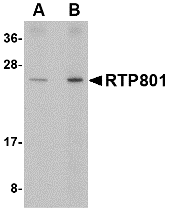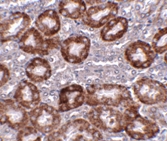Catalog# :4495
RTP801 was initially identified as a gene induced by DNA damage, and later found to also be regulated by other cellular stresses such as hypoxia and glucocorticoid treatment. Recently, RTP801 has been shown to act as a mediator of tuberous sclerosis complex (TSC)-dependent regulation of the mammalian Target of Rapamycin (mTOR), an evolutionarily conserved serine/threonine kinase that regulates cell growth and cell cycle. In response to energy stress, RTP801 inhibits mTOR function, resulting in dephosphorylation of downstream targets such as ribosomal protein S6 kinase 1 and 4EBP1 and decreasing cell growth. Disregulation of RTP801 may thus contribute to human tumorigenesis.
Additional Names : RTP801 (IN), DNA damage inducible transcript 4, DDIT4, Dig2, REDD-1
 Description
DescriptionLeft: Western blot analysis of RTP801 in human kidney tissue lysate with RTP801 antibody at (A) 0.5 and (B) 1 µg/ml.
Below: Immunohistochemistry of RTP801 in mouse kidney tissue with RTP801 antibody at 5 µg/ml.
Other Product Images

Source :RTP801 antibody was raised against a 12 amino acid peptide from near the center of human RTP801.
Purification : Affinity chromatography purified via peptide column
Clonality and Clone : This is a polyclonal antibody.
Host : RTP801 antibody was raised in rabbit. Please use anti-rabbit secondary antibodies.
Application : RTP801 antibody can be used for the detection of RTP801 by Western blot at 0.5 – 1 µg/ml.
Tested Application(s) : E, WB, IHC
Buffer : Antibody is supplied in PBS containing 0.02% sodium azide.
Blocking Peptide :Cat.No. 4495P - RTP801 Peptide
Long-Term Storage : RTP801 antibody can be stored at 4ºC, stable for one year. As with all antibodies care should be taken to avoid repeated freeze thaw cycles. Antibodies should not be exposed to prolonged high temperatures.
Positive Control :
1. Cat. No. 1305 - Human Kidney Tissue Lysate
Species Reactivity : H, M, R
GI Number : 9506687
Accession Number : NP_061931
Short Description : (IN) DNA damage inducible transcript 4
References
1. Ellisen LW, Ramsayer KD, Johannessen CM, et al. REDD1, a developmentally regulated transcriptional target of p63 and p53, links p63 to regulation of reactive oxygen species. Mol. Cell 2002; 10:995-1005.
2. Shoshani T, Faerman A, Mett I, et al. Identification of a novel hypoxia-inducible factor 1-responsive gene, RTP801, involved in apoptosis. Mol. Cell. Biol. 2002; 22:2283-93.
3. Wang Z, Malone MH, Thomenius MJ, et al. Dexamethasone-induced gene 2 (dig2) is a novel pro-survival stress gene induced rapidly by diverse apoptotic signals. J. Biol. Chem. 2003; 278:27053-8.
4. Sofer A, Lei K, Johannessen CM, et al. Regulation of mTOR and cell growth in response to energy stress by REDD1. Mol. Cell. Biol. 2005; 25:5834-45

No comments:
Post a Comment